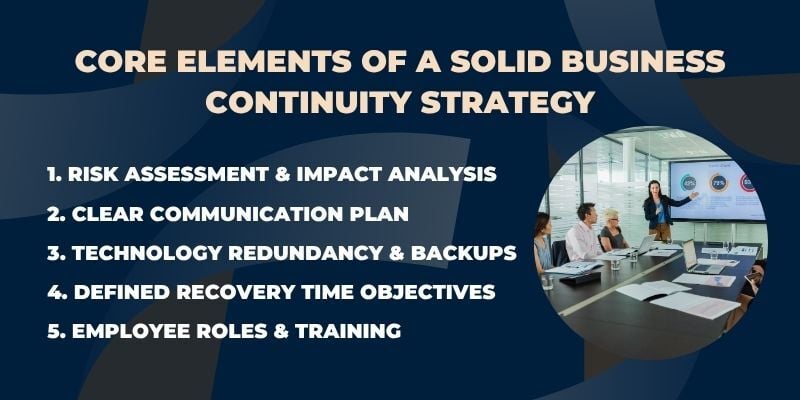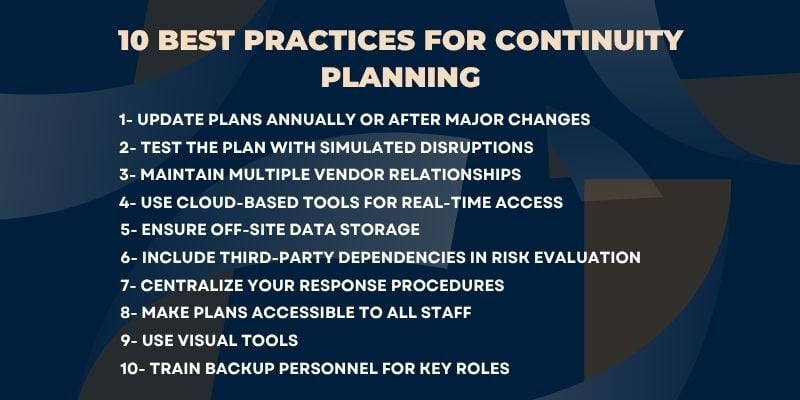Every business, big or small, runs the risk of unexpected disruptions. A system outage, a delayed software upgrade, or even a cyber-attack can bring operations to a halt.
That’s where a business continuity strategy comes in. It’s a plan that helps keep essential services running when things don’t go as expected.
Knowing how to ensure business continuity is especially important during system upgrades. These upgrades are necessary, but they can introduce risks if not managed carefully. Without a clear plan, teams may face downtime, data loss, or customer dissatisfaction.
This blog covers practical steps and proven methods to help you maintain stability during system upgrades.
From planning ahead to testing backup systems, we’ll walk through the actions that can reduce risk and keep your business on track, even when facing technical changes.
Whether you’re updating software, replacing infrastructure, or shifting to new platforms, a solid continuity plan can make all the difference.
What is a Business Continuity Strategy?
A business continuity strategy is a clear and structured plan that helps a company continue operating during and after unexpected disruptions.
It outlines how essential functions will keep running if regular systems or processes are affected. This could include events like system failures, cyber incidents, or even natural disasters.
The scope of business continuity planning includes people, processes, and infrastructure. This involves ensuring that employees understand their roles during a disruption, identifying which operations are critical, and having the necessary systems and resources in place to support them.
It’s important to know the difference between business continuity and disaster recovery. Business continuity focuses on maintaining business operations during a disruption, whereas disaster recovery is concerned with restoring systems and data after a disruption has occurred. Both are necessary, but they serve different roles.
Today, more companies are taking this seriously. Roughly 61% of businesses worldwide now have a business continuity plan in place.
Many are doing this to strengthen their ability to maintain services and deliver a consistent customer experience through effective continuity planning.
Core Elements of a Solid Business Continuity Strategy

A strong business continuity strategy is built on more than just good intentions. It requires detailed planning, coordination, and regular updates.
Below are the core components that support a reliable and resilient approach to maintaining stable operations during system upgrades or disruptions:
1. Risk Assessment & Impact Analysis
The first step in any business continuity framework is understanding potential risks. These can include internal issues, such as system failures or staffing shortages, as well as external threats, including supply chain disruptions, cyberattacks, or extreme weather events.
Risk assessment helps organizations prepare for scenarios that could interrupt operations.
Business Impact Analysis (BIA) goes a step further by identifying which business functions are most critical and what the consequences would be if they were interrupted.
For example, when Delta Airlines suffered a major IT outage in 2016 due to a power failure, over 2,000 flights were canceled, and the financial loss exceeded $150 million.
This event highlighted how a gap in risk planning and impact analysis in core IT infrastructure can affect the entire operation.
2. Clear Communication Plan
Communication during a disruption can make the difference between a calm response and widespread confusion. A clear communication plan outlines how to keep employees, partners, and customers informed during system upgrades or outages.
This includes using channels like internal emails, mobile apps, public alerts, digital signage, and even physical signage where necessary.
Using digital signage for real-time internal communication can help reduce stress and ensure that staff remain informed promptly. These systems support a smoother customer journey by setting expectations early and providing timely updates.
Typical systems used in communication plans include:
- Mass email systems
- Company messaging apps (e.g., Slack, Teams)
- Emergency notification services
- On-site signage and alert boards
3. Technology Redundancy & Backups

Technology failures are often unavoidable, but their impact can be minimized with proper redundancy and backup systems. Automated data backups and cloud-based storage can help ensure that vital information is never lost, even during a system upgrade or unexpected crash.
IT redundancy includes having duplicate servers, alternate network routes, or spare hardware that can take over if the primary system fails.
During customer-facing disruptions, digital signage and queue systems help manage expectations and guide people to the right resources.
Wavetec’s Queue Management System (QMS) allows organizations to maintain order and provide timely updates, helping keep operations steady and customers informed during technical challenges.
4. Defined Recovery Time Objectives (RTO)
Setting Recovery Time Objectives (RTO) helps a business determine how quickly critical operations must be restored. Without these targets, it’s difficult to decide what level of investment is needed in infrastructure or backup systems.
For example, if a payment processing system must be restored within 30 minutes to avoid revenue loss, the continuity plan must include high-speed recovery tools and failover systems.
This kind of planning supports the disaster recovery approach and helps justify the cost of preparedness.
A recent 2024 survey indicates that the average cost of unplanned IT downtime rose to $14,056 per minute, a nearly 10% increase from 2022. Additionally, over 90% of mid-size and large companies report that an hour of downtime now typically exceeds $300,000.
5. Employee Roles & Training
Technology alone is insufficient to sustain a business during a disruption. Employees need to know exactly what to do when systems go down or unexpected issues arise. A good continuity plan clearly defines each person’s role and responsibilities during an emergency.
Regular training helps teams stay prepared. Running mock drills and simulations allows staff to practice their tasks in real-world scenarios. This builds confidence and reduces hesitation when quick action is needed.
It’s also important to keep playbooks updated with step-by-step instructions so that employees have a clear guide to follow at any time.
Clear responsibilities, practical training, and easy-to-access instructions are all essential parts of continuity plan development.
10 Best Practices for Continuity Planning

Strong continuity planning doesn’t end with a written document. It requires regular updates, testing, and integration into daily operations. Below are the ten best practices to enhance operational resilience planning and ensure your business is prepared for disruptions.
- Update plans annually or after major changes: Review your continuity plan at least once a year, or whenever your business undergoes a significant change, such as system upgrades, office relocation, or staff changes. This keeps your plan aligned with current operations and avoids outdated procedures.
- Test the plan with simulated disruptions: Simulations allow teams to practice responses in a controlled environment. Testing helps identify gaps, improve coordination, and ensures that everyone knows what to do under pressure.
- Maintain multiple vendor relationships: Relying on a single vendor can increase risk. Having backup suppliers or service providers adds flexibility and makes it easier to continue operations if one partner becomes unavailable.
- Use cloud-based tools for real-time access: Storing critical applications and documents in the cloud allows employees to access essential systems from anywhere. This supports digital transformation by making continuity plans more responsive and scalable.
- Ensure off-site data storage: Keeping a secure copy of business data at a separate location protects your organization in case of localized disruptions such as power outages or natural disasters.
- Include third-party dependencies in risk evaluation: Vendors, partners, and service providers should be part of your risk assessment. If they experience issues, your business might feel the impact. Identify these connections early to reduce surprises.
- Centralize your response procedures: Having a single command structure during disruptions makes it easier to manage decisions and reduce confusion. A centralized approach improves coordination across departments and teams.
- Make plans accessible to all staff: A continuity plan is only useful if it can be easily found. Store it in shared digital locations and ensure employees know where to access it during emergencies.
- Use visual tools: Dashboards provide real-time updates, while dynamic digital signage can share instructions or alerts in shared spaces. These systems improve communication during disruptions, especially when fast action is required.
- Train backup personnel for key roles: Unexpected absences can slow recovery. Training backup staff ensures that essential responsibilities are always covered, even if primary team members are unavailable.
Integrating Digital Transformation into Your Continuity Plan
Digital upgrades can strengthen a continuity plan, especially when customer interaction is involved. Adding self-service kiosks, queue management systems, and digital signage can keep operations flowing when regular service points are offline.
For example, Wavetec worked with Delta Sky Club lounges in the US to implement ticket-dispensing kiosks paired with SMS notifications and Spectra dashboards.
Members could grab a virtual ticket, receive updates on queue status, and get notified when it was their turn, all without human intervention. That setup kept lounge services running smoothly, even during staff shortages or temporary system issues.
LED displays can also alert customers when a branch area is closed, show current wait times, and provide navigation tips. The combination of kiosks and displays means fewer interruptions to the customer experience and quicker recovery from disruptions.
Ultimately, automating customer-facing communication allows information to flow without relying on staff. Including systems like kiosks and displays in your continuity plan helps keep customers informed and services running smoothly, even when regular operations are disrupted.
Conclusion
Business continuity planning is not something to consider only when trouble arises. It’s a core part of staying prepared and protecting daily operations.
Disruptions can come from software updates, supply chain delays, or power outages — not just large-scale disasters. A clear, well-tested plan helps reduce downtime, protect data, and keep customers informed.
Being proactive allows businesses to respond with confidence instead of scrambling under pressure. Whether you already have a plan or are starting from scratch, now is the time to review, refine, and improve.
Focus on what matters most: keeping people safe, services running, and communication clear. Strong planning today builds the foundation for better decisions and faster recovery in the future.
BOOK A FREE DEMO





